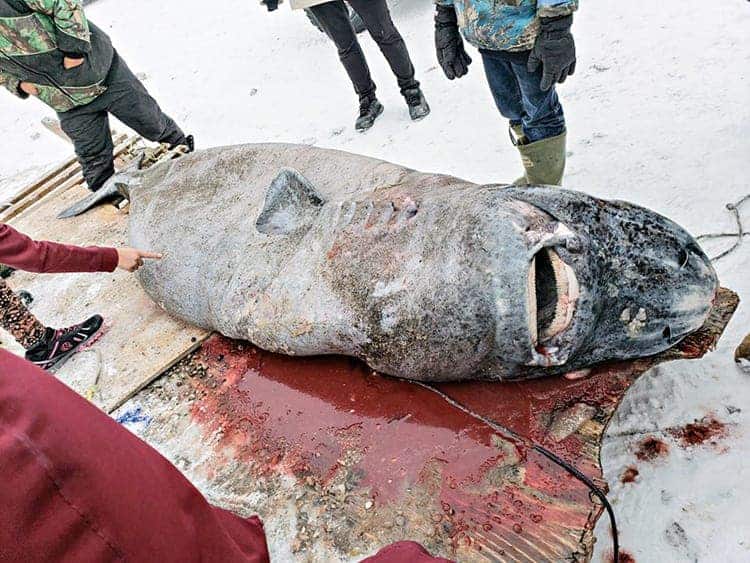One of the longest-living vertebrates known on Earth, a Greenland shark, was caught in a whaling net near Coral Harbour on Oct. 1.
The rare catch measured more than three metres (10 feet) in length and weighed close to 227 kilograms (500 pounds).
Moses Nakoolak said he had never seen anything like it in his more than 30 years of setting whale nets.
He said he and his son, Moses Jr., found a large, unusual creature trapped in one the nets they pulled up about five kilometres outside of the community.
“I was thinking maybe it’s a walrus because it’s way too heavy,” said Moses.
“We pulled it up to the shore and my son recognized it right away. ‘It’s a Greenland shark! It’s a Greenland shark!’”

Photo courtesy Jeffrey Ottokie
Greenland sharks are large, cold-water sharks often found at great depths.
They are known as opportunistic predators that will eat just about any meat they find, dead or alive.
In 2016, researchers used radiocarbon dating to determine the ages of 28 Greenland sharks and estimated the two biggest to be between 335 and 392 years old.
The majority of Greenland sharks are blind due to pinkish-white parasites (copepods) that hang from their eyes. The parasites attach themselves to the shark’s cornea.
According to an article by Holly Chavez for Oceanwide Expeditions, the meat of the Greenland shark can cause symptoms in humans similar to severe inebriation, and the neurotoxins in their flesh can be incapacitating to sled dogs.
The toxicity is due to trimethylamine oxide (TMAO) in the tissue of Greenland shark flesh, which helps the fish stabilize their enzymes and structural proteins against the debilitating effects of severe cold and high water pressure.
The shark meat can be prepared in a fermentation process that removes the TMAO, resulting in a much-enjoyed national dish of Iceland, known as Hákarl or kæstur hákarl.
It is prepared by hanging the meat of the Greenland shark up to dry for four to five months, which removes the adverse effects of the neurotoxins.
Moses said they’d never seen a Greenland shark in anyone’s nets in Coral Harbour.
“This is the very first time we saw that caught in the whale nets,” he said. “We normally catch narwhal and beluga.”
Moses and his son put the shark on a qamutiik and brought it back to his home.
Along the way some curious community members began following them to get a glimpse of the oddity.
Since then, many people have stopped by to take a look and snap photos.
Jeffrey Ottokie had to get an up-close look for himself.
“Jeez, that thing is not the smoothest. It’s really rough skin... if it was alive I’d never touch it,” said Ottokie.
“It’s the first time we’ve seen a whole Greenland shark like that.
“It’s quite amazing to see that.”
Moses said he’s heard Greenlandic people boil the shark meat and eat it. Others have said it’s generally used as dog food.
“I have no clue at all what I’m going to do with it,” he laughed.